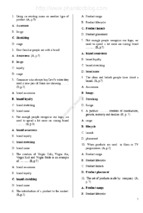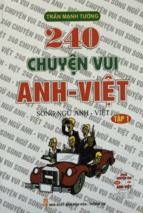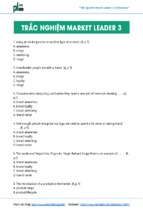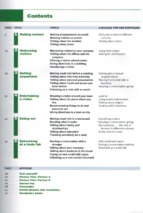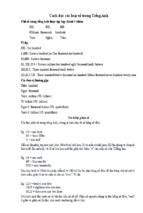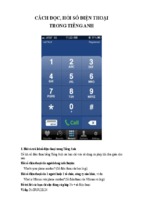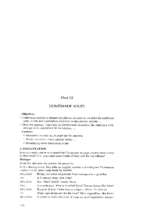MARKETING VOCABULARY
From the Glossary of Marketing Management (2002) of Phillip Kotler.
Editted by TuongKinhQuoc – CMVC – 13/03/2007
To my Dad with love on his birthday.
Look for... A
Look for... B
Look for... C
Look for... D
Look for... E
Look for... F
Look for... G
Look for... H
Look for... I
Look for... J
Look for... K
Look for... L
Look for... M
Look for... N
Look for... O
Look for... P
Look for... Q
Look for... R
Look for... S
Look for... T
Look for... U
Look for... V
Look for... W
Look for... A
* Accessibility.
* Action ability.
* Actual product.
* Adapted marketing mix.
* Administered VMS.
* Adoption.
* Adoption process.
* Advertising.
* Advertising objective.
* Advertising specialties.
* Affordable method.
* Age and life-cycle segmentation.
* Agent.
* Allowance.
* Alternative evaluation.
* Annual plan.
* Approach.
* Atmospheres.
* Attitude.
* Augmented product.
* Available market.
Look for... B
* Balance sheet.
* Barter transaction.
* Basing-point pricing.
* Behavioral segmentation.
* Belief.
* Bench marking.
* Benefit segmentation.
* Brand.
* Brand equity.
* Brand extension.
* Brand image.
* Break-even pricing (target profit pricing).
* Broker.
* Business analysis.
* Business buying process.
* Business market.
* Business portfolio.
* Buyer.
* Buyer-readiness stages.
* Buyers.
* Buying centre.
* By-products.
* By-product pricing.
Look for... C
* Capital items.
* Captive-product pricing.
* Cash-and-carry retailers.
* Cash-and-carry wholesalers.
* Cash cows.
* Cash discount.
* Cash refund, offers (rebates).
* Catalogue marketing.
* Catalogue showroom.
* Category killers.
* Causal research.
* Channel conflict.
* Channel level.
* Closed-end questions.
* Closing.
* Co-branding.
* Cognitive dissonance.
* Commercial online services.
* Commercialization.
* Company and individual brand strategy.
* Comparison advertising (knocking copy).
* Competitions sweepstakes, lotteries, games.
* Competitive advantage.
* Competitive-parity method.
* Competitive strategies.
* Competitor analysis.
* Competitor-centered company.
* Complex buying behavior.
* Concentrated marketing.
* Concept testing.
* Consumer buying behavior.
* Consumer market.
* Consumer-oriented marketing.
* Consumer product.
* Consumer promotion.
* Consumer relationship-building promotions.
* Consumerism.
* Continuity Scheduling.
* Contract manufacturing.
* Contractual VMS.
* Convenience product.
* Convenience store.
* Conventional distribution channel.
* Copy testing.
* Core product.
* Core strategy.
* Comer sump.
* Corporate brand strategy.
* Corporate licensing.
* Corporate VMS.
* Corporate Web site.
* Cost of goods sold.
* Cost-plus pricing.
* Counter trade.
* Coupons.
* Critical success factors.
* Cultural empathy.
* Cultural environment.
* Cultural universals cultural.
* Culture.
* Current marketing situation.
* Customer-centered company.
* Customer database.
* Customer delivered value.
* Customer lifetime value.
* Customer sales force structure.
* Customer satisfaction.
* Customer value.
* Customer value analyses.
* Customer value delivery system.
* Cycle.
Look for... D
* Decider.
* Deciders.
* Decision-and-reward system.
* Decision-making unit (DMU).
* Decline stage.
* Deficient products.
* Demand curve.
* Demands.
* Demarketing.
* Demographic segmentation.
* Demography.
* Department store.
* Derived demand.
* Descriptive research.
* Desirable products.
* Differential advantage.
* Differentiated marketing.
* Direct investment.
* Direct-mail marketing.
* Direct marketing.
* Direct-marketing channel.
* Direct-response television marketing (DRTV).
* Discount.
* Discount store.
* Dissonance-reducing buying behavior.
* Distribution centre.
* Distribution channel (marketing channel).
* Diversification.
* Dogs.
* Door-to-door retailing.
* Durable product.
Look for... E
* Economic environment.
* Electronic commerce.
* Embargo.
* Emotional appeals.
* Emotional selling proposition (ESP).
* Engel's laws.
* Enlightened marketing.
* Environmental management perspective.
* Environmentalism.
* Events.
* Exchange.
* Exchange controls.
* Exclusive distribution.
* Experience curve (learning curve).
* Experimental research.
* Exploratory research.
* Export department.
* Exporting.
* External audit.
Look for... F
* Fads.
* Family life cycle.
* Fashion.
* Financial Intermediaries.
* Fixed costs.
* FOB-origin pricing.
* Focus group.
* Follow-up.
* Forecasting.
* Fragmented industry.
* Franchise.
* Franchise organization.
* Freight-absorption pricing.
* Frequency.
* Full service retailers.
* Full service wholesalers.
* Functional discount (trade discount).
Look for... G
* Gatekeepers.
* Gender segmentation.
* General need description.
* Geodemographics.
* Geographic segmentation.
* Geographical pricing.
* Global firm.
* Global industry.
* Global marketing.
* Global organization.
* Going-rate pricing.
* Government market.
* Gross margin.
* Gross sales.
* Growth-share matrix
* Growth stage.
Look for... H
* Habitual buying behavior.
* Handling objections.
* Horizontal marketing systems.
* Human need.
* Human want.
* Hybrid marketing channels.
* Hypermarkets.
Look for... I
* Idea generation.
* Idea screening.
* Implausible positioning.
* Income segmentation.
* Individual marketing.
* Industrial product.
* Industry.
* Inelastic demand.
* Influencer.
* Information search.
* Informative advertising.
* Initiator.
* Innovation.
* Innovative marketing.
* Institutional market.
* Integrated direct marketing.
* Integrated logistics management.
* Integrated marketing communications.
* Intensive distribution.
* Interactive marketing.
* Intermediaries.
* Internal audit.
* Internal marketing.
* Internal records information.
* International division.
* International market.
* Internet (the Net).
* Introduction stage.
* Invention.
Look for... J
* Joint ownership.
* Joint venturing.
Look for... K
* Key account managers.
Look for... L
* Leading indicators.
* Learning.
* Licensed brand.
* Licensing.
* Life-cycle segmentation.
* Lifestyle.
* Limited-service wholesalers.
* Line extension.
Long-range plan.
Look for... M
* Macro environment.
* Management contracting.
* Manufacturer's brand (national brand).
* Market.
* Market-build-up method.
* Market-centered company.
* Market challenger.
* Market development.
* Market-factor index method.
* Market follower.
* Market leader.
* Market nicher.
* Market penetration.
* Market-penetration pricing.
* Market positioning.
* Market segment.
* Market segmentation.
* Market Skimming pricing.
* Market targeting.
* Marketing.
* Marketing audit.
* Marketing budget.
* Marketing concept.
* Marketing control.
* Marketing database.
* Marketing environment.
* Marketing implementation.
* Marketing information system (MIS).
* Marketing intelligence.
* Marketing intermediaries.
* Marketing management.
* Marketing mix.
* Marketing process.
* Marketing research.
* Marketing services agencies.
* Marketing strategy.
* Marketing strategy statement.
* Marketing Web site.
* Mark-up, mark –down.
* Mass customization.
* Mass marketing.
* Materials and parts.
* Maturity stage.
* Measurability.
* Media.
* Media impact.
* Media vehicles.
* Membership groups.
* Merchant wholesalers.
* Message source.
* Micro environment.
* Micromarketing.
* Mission statement.
* Modified rebuy.
* Monetary transaction.
* Monopolistic competition.
* Moral appeals.
* Motive drive.
* Multi-brand strategy.
* Multiple niching.
Look for... N
* Natural environment.
* Need recognition.
* Net profit.
* New product.
* New-product development.
* New task.
* Niche marketing.
* Non-durable product.
* Non-personal communication channels.
* Non-tariff trade barriers.
Look for... O
* Objective-and-task method.
* Observational research.
* Occasion segmentation.
* Oligopolistic competition.
* Online advertising.
* Online marketing.
* Open-end questions.
* Operating control.
* Operating statement (profit-and-loss statement or income statement).
* Opinion leaders.
* Optional-product pricing.
* Order-routine specification.
* Overpositioning.
Look for... P
* Packaging.
* Packaging concept.
* Patronage rewards.
* Penetrated market.
* Percentage-of-sales method.
* Perception.
* Perceptual maps.
* Performance review.
* Personal communication channels.
* Personal influence.
* Personal selling.
* Personality.
* Persuasive advertising.
* Physical distribution (marketing logistics).
* Physical distribution firms.
* Place.
* Planned obsolescence.
* Pleasing products.
* Point-of-purchase (POP) promotions.
* Political environment.
* Portfolio analysis.
* Post-purchase behavior.
* Potential market.
* Pre-approach.
* Premiums.
* Presentation.
* Price.
* Price elasticity.
* Price packs.
* Primary data.
* Primary demand.
* Private brand (middlemen, distributor or store brand).
* Problem recognition.
* Product.
* Product adaptation.
* Product-bin file pricing.
* Product concept.
* Product development.
* Product idea.
* Product image.
* Product innovation charter (PIC).
* Product invention.
* Product life cycle (PLC).
* Product line.
* Product line filling.
* Product line pricing.
* Product line stretching.
* Product mix (product assortment).
* Product position.
* Product quality.
* Product sales force structure.
* Product specification.
* Product-support services.
* Production concept.
* Promotion.
* Promotion mix.
* Promotional allowance.
* Promotional pricing.
* Proposal solicitation.
* Prospecting.
* Psychographic segmentation.
* Psychographics.
* Psychological pricing.
* Public.
* Public relations.
* Publicity.
* Pull strategy.
* Pulsing.
* Pure competition.
* Pure monopoly.
* Push strategy.
Look for... Q
* Qualified available market.
* Qualitative research.
* Quality.
* Quantitative research.
* Quantity discount.
* Quantity premium.
* Question marks.
* Quota.
Look for... R
* Range branding strategy.
* Rational appeals.
* Reach
* Reference groups.
* Reference prices.
* Relationship marketing.
* Reminder advertising.
* Resellers.
* Retailer co-operatives.
* Retailers.
* Retailing.
* Retailing accordion.
* Role.
Look for... S
* Sales force management.
* Sales force promotion.
* Sales promotion.
* Sales quotes.
* Salesperson.
* Salutary products.
* Sample.
* Samples.
* Scaled-bid pricing.
* Seasonal discount.
* Seasonally.
* Secondary data.
* Segment marketing.
* Segmented pricing.
* Selective attention.
* Selective demand.
* Selective distortion.
* Selective distribution.
* Selective retention.
* Self-expect.
* Self-service retailers.
* Selling concept.
* Selling process.
* Sense-of-infusion marketing.
* Sequential product development.
* Served market (target market).
* Service.
* Service inseparability.
* Service intangibility.
* Service perishability.
* Service variability.
* Services.
* Shopping product.
* Simultaneous product development.
* Single-source data systems.
* Soda classes.
* Societal marketing.
* Societal marketing concept.
* Specialty product.
* Specialty store.
* Specialized industry.
* Stalemate industry.
* Standardized marketing mix.
* Stars.
* Statistical demand analysis.
* Status.
* Straight product extension.
* Straight rebuy.
* Strapline.
* Strategic business-planning grid.
* Strategic business unit (SBU).
* Strategic control.
* Strategic focus.
* Strategic group.
* Strategic plan.
* Strategic planning.
* Style.
* Subculture.
* Substantiality.
* Supermarkets.
* Superstore.
* Supplier search.
* Supplier selection.
* Suppliers.
* Supplies and services.
* Survey research.
* SWOT analysis.
* Systems buying.
Look for... T
* Target costing.
* Target market.
* Target marketing.
* Target profit pricing. See Break-even pricing.
* Tariff.
* Team selling.
* Technologies environment.
* Telemarketing.
* Television marketing.
* Territorial sales force structure.
* Test marketing.
* Time-series analysis.
* Total costs.
* Total customer cost.
* Total customer value.
* Total market demand.
* Total quality management (TQM).
* Trade-in allowance.
* Trade (or retailer) promotion.
* Transaction.
* Trend.
* Two-part pricing.
Look for... U
* Underpositioning.
* Undifferentiated marketing.
* Uniform delivered pricing.
* Unique selling proposition (USP).
* Unsought product.
* User.
* Users.
Look for... V
* Value pricing.
* Value analysis.
* Value-based pricing.
* Value chain.
* Variable costs.
* Variety-seeking buying behavior.
* Variety store.
* Volume industry.
Look for... W
* Warehouse club (wholesale club, membership warehouse).
* Webcasting (push programming).
* Wheel of retailing.
* Wholesaler.
* Word-of-mouth influence.
* Workload approach.
* World Wide Web (WWW or the Web).
Look for... Z
* Zone pricing.
* Accessibility.
The degree to which a market segment can be reached and served.
* Action ability.
The degree to which effective programs can be designed for attracting and serving a given market
segment.
* Actual product.
A product's parts, quality level, features, design, brand name, packaging and other attributes that
combine to deliver core product benefits.
* Adapted marketing mix.
An international marketing strategy for adjusting the marketing-mix elements to each international
target market, hearing more casts but hoping for a larger market share and return.
* Administered VMS.
A vertical marketing system that coordinates successive stages of production and distribution , not
through common ownership or contractual lies, but through the size and power of one of the parties.
* Adoption.
The decision by an individual to become a regular user of the product.
* Adoption process.
The mental process through which an individual passes from first hearing about an innovation to final
adoption.
* Advertising.
Any paid form of non personal presentation and promotion of ideas, goods or services by an
identified sponsor.
* Advertising objective.
A specific communication task to be accomplished with a specific target audience during a specific
period of time.
* Advertising specialties.
Useful articles imprinted with an advertiser's name, given as gifts to consumers.
* Affordable method.
Setting the promotion budget at the level management thinks the company can afford.
* Age and life-cycle segmentation.
Dividing a market into different age and life-cycle groups.
* Agent.
A wholesaler who represents buyers or sellers on a relatively permanent basis, performs only a few
functions, and does not take tide to goods.
* Allowance.
(1) Reduction in price on damaged goods or (2) promotional money paid by manufacturers to retailers
in return for an agreement to feature the manufacturer's product in some way.
* Alternative evaluation.
The stage of the buyer decision process in which the consumer uses information lo evaluate
alternative brands in the choice set.
* Annual plan.
A short-term plan that describes the company's current situation , its objectives, the strategy, action
program and budgets for the year ahead and controls.
* Approach.
The step in the selling process in which the salesperson meets and greets the buyer to get the
relationship off to a good start.
* Atmospheres.
Designed environments that create or reinforce the buyer's leanings towards consumption of a product.
* Attitude.
A person's consistently favorable or unfavorable evaluations, feelings and tendencies towards an
object or idea.
* Augmented product.
Additional consumer services and benefits built around the core and actual products.
* Available market.
The set of consumers who have interest, income and access to a particular product or service.
* Balance sheet.
A financial statement that shows assets, liabilities and worth of a company at a given time.
* Barter transaction.
A marketing transaction in which goods or services are traded for other goods or services.
* Basing-point pricing.
A geographic pricing strategy in which the seller designates some city as a basing point and charges
all customers the freight cost from that city to the customer location, regardless of the city from which the
goods are actually shipped.
* Behavioral segmentation.
Dividing n market into groups based on consumer knowledge, attitude, use or response to a product.
* Belief.
A descriptive thought that a person holds about something
* Bench marking.
The process of comparing the company's products and processes to those of competitors or leading
firms in other industries to find ways to improve quality and performance.
* Benefit segmentation.
Dividing the market into groups according to the different benefit that consumers sock from the
product
* Brand.
A name, term, sign, symbol or design, or a combination of these, intended to identify the goods or
services of one seller or group of sellers and to differentiate them from those of competitors.
* Brand equity.
The value of a brand, based on the extent to which it has high brand loyalty, name awareness,
perceived quality, strong brand associations, and other assets such as patents, trademarks and channel
relationships.
* Brand extension.
Using a successful brand name to launch a new or modified product in a new category.
* Brand image.
The set of beliefs that consumers hold about a particular brand.
* Break-even pricing (target profit pricing).
Getting price to break even on the costs of making aid marketing a ‘product’ or setting price to make a
target profit.
* Broker.
A wholesaler who does not take tide to goods and whose function is to bring buyers and sellers
together and assist in negotiation.
* Business analysis.
A review of the sales, costs and profit projections for a new product to find out whether these factors
satisfy the company's objectives.
* Business buying process.
The decision making process of which business buyers establish the need for purchased products and
services, and identify, evaluate and choose among alternative brands and suppliers.
* Business market.
All the organizations that buy goods and services to use in the production of other products and
services, or for the purpose of reselling or renting them to others at a profit.
* Business portfolio.
The collection of businesses and products that make up the company.
* Buyer.
The person who makes an actual purchase.
* Buyer-readiness stages.
The stages that consumers normally pass through on their way to purchase, including awareness,
knowledge, liking, preference, conviction and purchase.
* Buyers.
People in an organization's buying centre with formal authority to select the supplier and arrange
terms of purchase.
* Buying centre.
All the individuals and units that participate in the business buying-decision process.
* By-products.
Items produced as a result of the main factory process, such as waste and reject items.
* By-product pricing.
Setting a price for by-products in order to make the main product's price more competitive.
* Capital items.
Industrial goods built partly enter the finished product, including installations and accessory
equipment.
* Captive-product pricing.
Setting a price for products that must be used along with a main product, such as blades for a razor
and film for a camera.
* Cash-and-carry retailers.
Large, 'no-frills' stores that sell an extensive assortment of goods, and are noted particularly for their
bulk discounts.
* Cash-and-carry wholesalers.
Wholesalers that stock a limited line of fast-moving goods - such as groceries, toys, household goods,
clothes, electrical supplies and building materials - and that sell to small retailers and industrial firms for
cash and normally do not provide a delivery service * Cash cows.
Low-growth, high-share businesses or products; established and successful units that generate cash
that the company uses to pay its bills and support other business unit that need investment.
* Cash discount.
A price reduction to buyers who pay their bills promptly.
* Cash refund, offers (rebates).
Offers to refund part of the purchase price of a product to consumers who send a ‘proof of purchase’
to the manufacturer.
* Catalogue marketing.
Direct marketing through catalogues that are mailed to a select list of customers or made available in
stores.
* Catalogue showroom.
A retail operation that sells a wide selection of high mark-up, fast-moving, brand-name goods at
discount prices.
* Category killers.
A modern ‘breed’ of exceptionally aggressive 'off-price' retailers that offer branded merchandise in
clearly defined product categories at heavily discounted prices.
* Causal research.
Marketing research to test hypotheses about cause-and-effect relationships .
* Channel conflict.
Disagreement among marketing channel members on goals and roles - who should do what and for
what rewards.
* Channel level.
A layer of intermediaries that performs some work in bringing the product and its ownership closer to
the final buyer.
* Closed-end questions.
Questions that include all the possible answers and allow subjects lo make choices among them.
* Closing.
The step in the selling process in which the salesperson asks the customer for an order.
* Co-branding.
The practice of using the established brand names of two different companies on the same product.
* Cognitive dissonance.
Buyer discomfort caused by post purchase conflict.
* Commercial online services.
Companies that offer online information, entertainment, shopping and other marketing services to
subscribers who pay the company a monthly fee. They make use of their own dedicated networks and
operate their own computers which are connected to the Internet, thus offering somewhat better security
than the Internet.
* Commercialization.
Introducing a new product into the market.
* Company and individual brand strategy.
A branding approach that focuses on the company name and individual brand name .
* Comparison advertising (knocking copy).
Advertising that compares one brand directly or indirectly to one or more other brands.
* Competitions sweepstakes, lotteries, games.
Promotional events that give consumers the chance to win something - such as cash, trips or goods by luck or through extra effort.
* Competitive advantage.
An advantage over competitors gained by offering consumers greater value, either through lower
prices or by providing more benefits that justify higher prices.
* Competitive-parity method.
Selling the promotion budget to match competitors' on days.
* Competitive strategies.
Strategies that strongly position the company against competitors and that give the company the
strongest possible strategic advantage.
* Competitor analysis.
The process of identifying key competitors; assessing their objectives, strategies, strengths and
weaknesses, and reaction patterns; and selecting which competitors to attack or avoid.
* Competitor-centered company.
A company whose moves are mainly based on competitors' actions and reactions; it spends most of its
time tracking competitors' moves arid market shares and trying to find strategies to counter them.
* Complex buying behavior.
Consumer buying behavior in situations characterized by high consumer involvement in a purchase
and significant perceived differences among brands.
* Concentrated marketing.
A market coverage strategy in which a brand goes after a large share of one or a few
submarkets.
* Concept testing.
Testing new product concepts with a group of target consumers to find out if the concepts have strong
consumer appeal.
* Confused positioning.
A positioning error that leaves consumers with a confused image of the company, its
product or a brand.
* Consumer buying behavior.
The buying behavior of final consumers - individuals and households who buy goods and services for
personal consumption.
* Consumer market.
All the individuals and households who buy or acquire goods and services for personal consumption.
* Consumer-oriented marketing.
A principle of enlightened marketing which holds that a company should view and organize its
marketing activities from the consumers' point of view.
* Consumer product.
A product bought by final consumers for personal consumption.
- Xem thêm -


